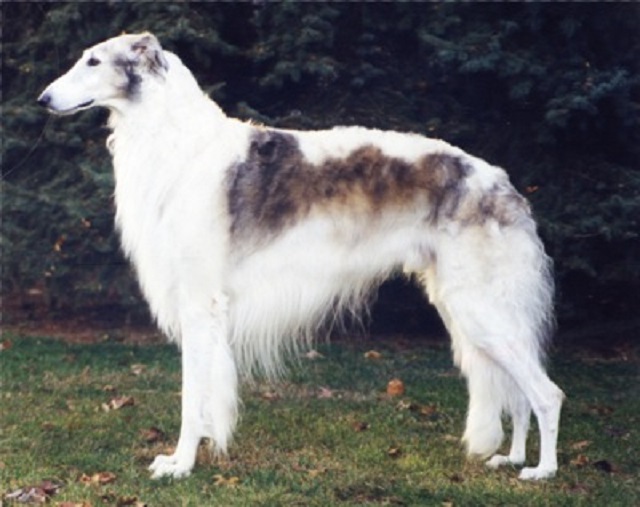
Borzoi

Navigate through the tabs
Navigate through the tabs below to view the breed's info of your interest.
The breed's info is divided in four sections; namely:
the breed's history ,
the breed's main stats ,
the dog's potential health issues
and finally, how the breed scored in 26 different categories.
All the above information should give you a respectively good overview for the dog of your interest.
Dog Breed's Main Info
The Breed's History:
Once known as the Russian Wolfhound, the Borzoi's written history can be traced to 1650, when the first standard for the breed was written in his homeland, Russia. Bred for hundreds of years by Russian nobles, the Borzoi is believed to have been developed from the early Russian bearhound, the coursing hounds of the Tatars, and the Owtchar, a tall sheepdog.
The hunts of the nobles were quite the spectacle. They might involve more than one hundred Borzoi, hunted in trios of one female and two males, as well as an equal number of foxhounds, which were used to seek and flush the prey. When the wolf was sighted, the huntsmen released their dogs to capture, pin, and hold it. After they ceremoniously bound and gagged the wolf, the huntsmen sometimes set it free to be hunted again another day. These lavish hunting expeditions were common until 1861, when the serfs were emancipated and the nobles could no longer rely on an unlimited work force.
By 1873, few Borzoi remained, alarming those who admired the breed's beauty and speed. Russian fanciers created the Imperial Association to protect and promote the breed's characteristics, and the bloodlines of many Borzoi in America can be traced to dogs from the kennels of Imperial Association members. The association's members included Grand Duke Nicholas, the uncle of Czar Nicholas II, and Artem Boldareff, a wealthy landowner.
Sadly, this association with the aristocracy was lethal. Many Borzoi were slaughtered after the Russian Revolution in 1918 because of it. The breed was saved only because many had been given as gifts to royals in other countries, including Queen Victoria and Alexandra, Princess of Wales, or had been imported by people interested in the breed.
The first Borzoi known to be imported to the United States was named Elsie, purchased from Britain by a Pennsylvania man named William Wade. Poor Elsie wasn't much to look at apparently, being described as "small, light, and weedy". Another American, C. Steadman Hanks, visited Russia in the 1890s and imported Borzoi directly from their homeland to establish his Seacroft Kennels.
The first Borzoi registered with the American Kennel Club was Princess Irma in 1891. In 1903, Joseph B. Thomas contributed to the establishment of the breed in America by making three trips to Russia to purchase dogs from the Perchino Kennel of Grand Duke Nicholas and the Woronzova Kennel of Artem Boldareff. The Borzoi Club of America, then known as the Russian Wolfhound Club of America, was formed that same year.
In 1936, the breed name was changed from Russian Wolfhound to Borzoi. Today, there is little difference between the Borzoi in your living room and his forebears in Mother Russia. He remains the same tall and glamorous sighthound that was one of the great treasures of Czarist Russia.
The Borzoi ranks 96th among the 155 breeds and varieties registered by the AKC.
Country of Origin:
Ukraine / Russia
Breed Group:
Hound
Height:
2 feet, 2 inch. to 2 feet, 8 inch. (66,04 to 81,28 cm)
Weight:
55 to 105 pounds (24,94 to 47,63 Kg)
Life Span:
10 to 12 years
Potential Health Issues:
Progressive Retinal Atrophy (PRA),
Osteochondrosis Dissecans (OCD),
Gastric Dilatation Volvulus (aka Gastric Torsion or Bloat)
Adaptability
Apartment Living:
First Time Owners:
Sensitivity:
Being Alone:
Cold Weather:
Hot Weather:
Friendliness
Affection With Family:
With Kids:
With Dogs:
With Strangers:
Health and Grooming
Shedding:
Drooling:
Easy To Groom:
Overall Health:
Weight Gain Potential:
Size:
Training
Easiness:
Intelligence:
Mouthiness:
Prey Drive:
Barking or Howling:
Wanderlust:
Need For Exercise
Energy Level:
Intensity:
Exercise Needs:
Playfulness:
Our Mobile Application
Check out Our Mobile Application "Dog Breeds Central"
